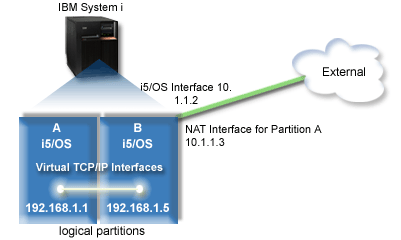Network address translation method
You can use IBM® i packet filtering to route traffic between a partition and the outside network.
The following figure is an example of using NAT to connect your
virtual Ethernet network to an external network. The 10.1.1.x network
represents an external network while the 192.168.1.x network
represents the virtual Ethernet network.

In this example, any existing TCP/IP traffic for
the system runs over the 10.1.1.2 interface. A new
interface, 10.1.1.3, is created for communicating between the 10.1.1.x
network and the 192.168.1.x network. Because this is a static map
scenario, the inbound traffic gets translated from the 10.1.1.3 interface
to the 192.168.1.5 interface. The outbound traffic
gets translated from the 192.168.1.5 interface to
the external 10.1.1.3 interface. Partition A and
partition B use their virtual interfaces 192.168.1.1 and 192.168.1.5 to
communicate with one another.
To make static NAT work, you need to first set up your IBM i and TCP/IP communications. Then you will create and apply some IP Packet rules. To configure virtual Ethernet to use the NAT method, complete these configuration tasks: